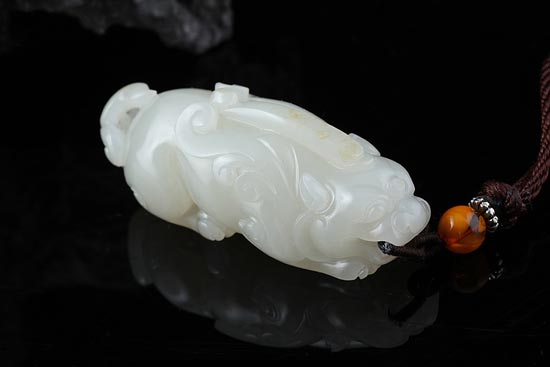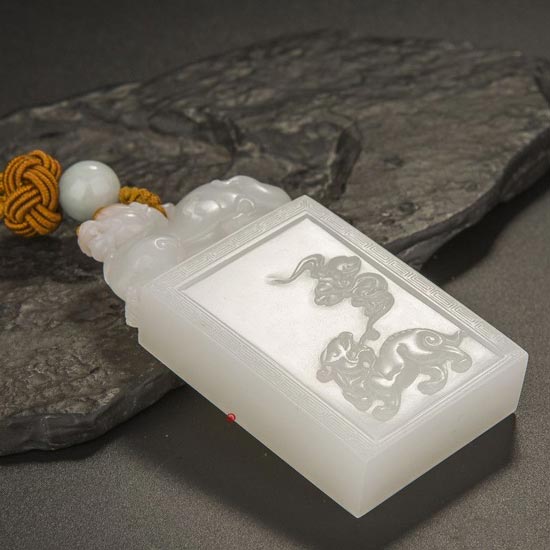How much do you know about the various carving techniques of Chinese jade carving?
Jade carving has a long history in China. At the earliest days in the Xia and Shang dynasties, jade became a profession, and jade became a ceremonial utensil and decorative piece. Jade has always been regarded as a treasure. In ancient China, jade was used as a symbol of good things and a symbol of gentleman's style. There are many varieties of jade carvings, mainly including large-scale works such as figures, utensils, birds, beasts and flowers, as well as small pieces such as pins, rings, seals and ornaments. Chinese jade carving works enjoy a high reputation in the world.
The jade is processed and carved into a beautiful handicraft called jade carving. In the process of making the craft, according to the natural color and natural shape of different jade materials, after careful design and repeated honing, the jade carving can be made into exquisite handicrafts. How much do you know about the techniques of various jade carvings?
The round sculpture, also known as the three-dimensional sculpture, is the overall expression of art on the carvings. The viewer can see the various sides of the object from different angles. It requires the sculptor to engrave all the way from front, back, left, right, top, middle and bottom. It is the most basic technique in stone carving. The round carvings generally open from the front, and require special attention to the unity and harmony of the angles and orientations of the works. Only in this way, the round sculptures can withstand the viewer's all-round "perspective".

Relief is a kind of sculpture that engraves the undulating image on the plane. It is an artistic expression between the sculpture and the painting. The spatial structure of the relief may be a three-dimensional three-dimensional form, or may have a certain planar form; it may be attached to a certain carrier or exist relatively independently.
Generally speaking, in order to meet the viewing needs or decorative needs of a specific viewpoint, the prominent feature of the relief relative to the circular sculpture is the two-dimensional or planar characteristic after the compression processing. The difference between embossing and round carving lies in its relative flatness and three-dimensionality. Its spatial form is the so-called compressed space between the two-dimensional virtual space that the painting has and the three-dimensional physical space that the round has. The compression space defines the free development of the embossed space. Under the background background, the sense of solidity of the round sculpture is weakened, and the virtual and illusion in painting and perspective are more adopted and used for performance purposes. Compared with the round sculpture, the relief mainly deals with the relationship between space and form according to the principle of painting. However, in the pursuit of the central image of aesthetic imagery, the relief and the round sculpture are completely identical, and the different forms of manipulation show only some appearance characteristics.
As one of the types of sculpture art, embossing firstly shows the general characteristics of sculpture art, that is, its aesthetic effect not only appeals to vision but also touch. At the same time, it can make good use of the advantages of painting art in composition, subject matter and spatial processing, and express the content and objects that can not be expressed by the sculpture, such as the background and environment of events and characters, and the continuity and turning of the festival. Free switching of different time and space perspectives, interspersing and overlapping of complex and diverse things. The carving and shaping on the plane enables the relief to combine the technical advantages of sculpture and painting, so that the shaping language of the relief is more narrative than other sculptures, especially round sculptures, without losing the expressiveness of the general sculpture.
In the relief work, the convex image portion is retained, and the back portion is partially or completely hollowed out, which is called openwork. The similarities and differences between openwork and enamel carving and chain carving show that all three are highly productive and penetrating, but the back of the openwork is mostly expressed in the form of inserting screens, with single-sided openwork and double-sided openwork. The single-sided openwork engraves only the front side, and the double-sided openwork engraves the objects on both sides of the front and back. Regardless of single-sided openwork or double-sided openwork, there is an essential difference between the carving and the chain carving. That is, the carving and the chain carving are all 360-degree engravings, not the front and the back. Therefore, the carvings and chains Carving is a round carving technique, while openwork is an extension of the relief technique.

Thin meaning, that is, extremely shallow relief, because of the thin layer of engraving, rich in painting, hence the name. It is a unique performance technique of Shoushan Stone Seal. Because of the fluency of the thin carving method, the elaboration is meticulous, and the shadows are fascinating, and they are highly appreciated and respected by the gold stone painters. The thin meaning is gradually derived from the relief technique. It is even shallower than the bas-relief. Because the engraving layer is thin and rich in painting, it is called "thin meaning." The thin carvings are known for their “emphasis, elegance, and closenessâ€. It combines calligraphy, engraving and painting. It is a unique art between painting and sculpture. For this reason, excellent thinness. The works often have extraordinary artistic charm, which is especially appreciated.
The eagle eagle is based on the embossed, hollowing out its background parts, some are single-sided carvings, and some are double-sided carvings. The eagle carving is also known as hollowing out and openwork. It refers to a technique for perforating various patterns and patterns on wood, stone, ivory, jade, ceramic body and other materials that can be used for engraving. In the late Neolithic period 5,000 years ago, the pottery has been perforated with round holes. All kinds of ceramic aromas from the Han Dynasty to the Wei and Jin Dynasties have an openwork pattern. At the time of the Qing Emperor Qianlong, the work of burning the heart, turning the neck and hollowing out the bottle, so that the level of such technology reached its peak.
Chain carving is a carving method that uses a piece of stone to sculpt a whole moving stone chain. The chain carving is also developed from the round carving technique. It was first seen in the carving of jade. Since the hardness of Shoushan Stone is lower than that of jade, it is more difficult to engrave the stone sculpture of Shoushan Stone. If it is slightly inadvertent, the chain is broken and the stone is destroyed. The chain carving of Shoushan Stone originated in the early Qing Dynasty.
Micro-carving generally refers to fine round carvings, reliefs and openwork (openwork carvings). What is more like the natural world. The micro-carving is convex and full of three-dimensionality. It can even be engraved on rice-sized ivory pieces, bamboo pieces or a few millimeters of hair. Its work can be viewed with a magnifying glass or a microscope to be engraved, so it has been called "stunt" in the past.
The button carving is a sculpture that refers specifically to the upper button of the seal. It belongs to the category of round sculpture and has a rich three-dimensional effect, but it has three remarkable features compared with the round sculpture. First, the object is small, limited to the size of the seal, generally less than 10 cubic centimeters; the second is only the upper part of the image, rather than the round sculpture, it needs a full range of performance; in addition, the performance of the button carving is mostly animals, Especially the ancient legendary animals.
The engraving is divided into two types: positive and negative. Yang engraved on the white Zhu Wen, the strokes are often slender and fluent; the inscription is the Zhudi white, the strokes are rough and vigorous, rich in the original inscription. The yin and the yin are paired in pairs, which complement each other and are particularly intriguing.
The engraving is particularly stressful. There are more than 20 kinds of books, such as Daxie and Xiaoyan, and there are also "changes." Which type of script is to be used depends on the layout of the printed surface. Under normal circumstances, it is wonderful to be a white and white person. The engraved person should have a good command of the book, and should be familiar with the calligraphy of the calligraphy. Shoushan stone engraving works often do not need to be polished, but the reality is vivid and natural.
Inlay, also known as screen carving, belongs to the category of small reliefs. In China, the inlaid history of gold jade jewelry as a decoration is very long, but the inlay and the stone carving of Shoushan are first seen in the early Qing Dynasty. The Shoushan stone carving was inlaid on other linings and formed a technique, but it was the first in the 1970s for Lin Shouzhen, the descendant of the Shoushan stone carving "East Gate School". The specific method is to disassemble the Shoushan stone tablets of different colors according to the pre-designed pictures, engrave them into floating reliefs, and then embellish them on the screens, hanging frames, table screens or utensils of the lacquer ware according to the artwork. . The background of this technique has two aspects. First, the color of Shoushan Stone is very rich, and there are everything in the world. Second, Fuzhou is the hometown of traditional crafts in the country. It is said to be a combination of lacquer ware and lacquer ware.
Long Sleeve Jacket,Long Sleeve Coat,Coats With Extra Long Sleeves,Long Sleeve Casual Coat
Shaoxing Newleaf Foreign Trade CO.LTD , https://www.newleafclothes.com